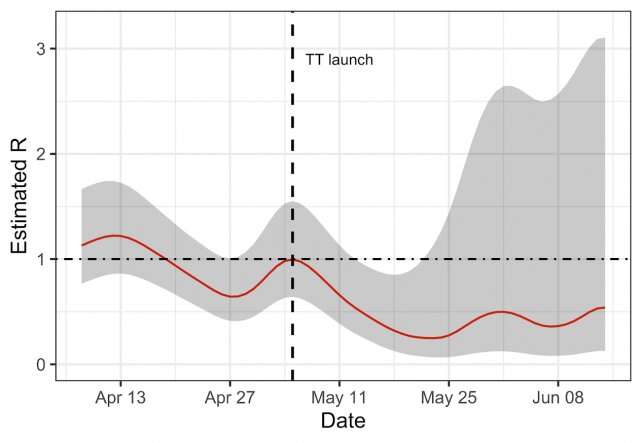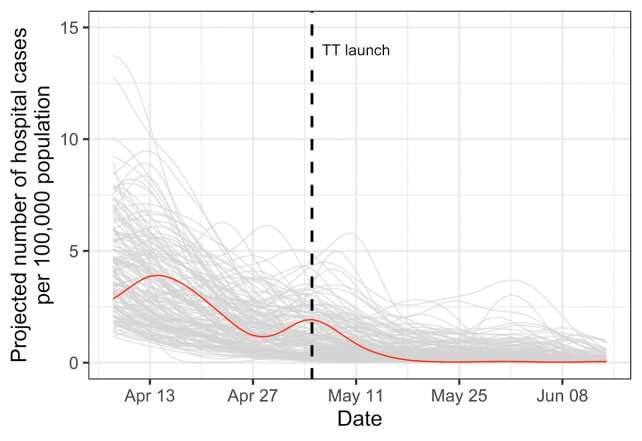Credit: AI-generated image (disclaimer)
A Test and Trace (TT) program was rolled out across the UK in May 2020, first on the Isle of Wight (5 May) and then nationwide (18-28 May). The Isle of Wight's program included version 1 of the NHS contact tracing app. We looked to see if the Isle of Wight's epidemic changed after the TT launch and if the island fared any differently from comparable areas of the UK.
Using Public Health England's daily "case counts" (positive swabs) we developed a method to estimate the number of new infections per day—there is a lag because people rarely get swabbed the day they are infected. The graph below shows Pillar 1 (hospital testing) case counts on the Isle of Wight in green, and our estimated number of new infections per day in red. New infections were decreasing from mid-April. There was a slight increase at the end of April, possibly an artifact of increased testing on 5th May, but then a noticeable decrease in infections despite the increased testing shortly after the TT launch.
Figure 1. Isle of Wight Pillar 1 data used to back-calculate estimation of incidence of new infections (red) from COVID-19 case data (green). Credit: Oxford Science Blog
Similarly, the reproduction number R—the average number of further infections each infected person causes—decreased rapidly on the island following the TT launch as shown by the red line below:
Figure 2. Isle of Wight Pillar 1 data (red line) used to estimate R, together with confidence intervals (grey shade). Credit: Oxford Science Blog
But how did the Isle of Wight compare to other areas? We used a variety of methods which all led to the same conclusion: something quite different happened on the Isle of Wight. The incidence and R rate dropped more rapidly than for other areas over comparable time periods. The graph below is a "nowcast" of the expected number of new hospital cases in the near future. The island had a sizeable epidemic in April-May, positioned "middle of the pack" in comparison with other areas; by June-July it led the way with case counts down to less than one a week, even when we included Pillar 2 (community tested) cases. Using a Maximum-Likelihood method we found that from March-May the Isle of Wight was ranked amongst the worst R rates in England (147th out of 150) but by mid-June it was positioned 10th best.
Figure 3. Pillar 1 data showing a simple "nowcast" for 150 local authorities to quantify the combined effects of R and incidence; the Isle of White shown in red. Credit: Oxford Science Blog
We have made our analyzes available in this interactive EpiNow-C19 tool which updates daily. It allows you to view the epidemic trend in each of the 150 local authorities to identify successes and hotspots, including the most recent surges in Leicester, Herefordshire and Blackburn with Darwen.
The success on the Isle of Wight is striking, and the course of its epidemic was different from other areas—a statistically significant difference. To prove that the TT program was the cause of the success would require ruling out all other possible causes, for which we would need more data. The island's epidemic control certainly warrants further investigation because it might translate to other local and national strategies.
If TT did have an impact we will also need to disentangle which aspects had the greatest effect. Was it the huge advertising campaign at the launch? Did people self-isolate more carefully after a positive test result? Was the contact tracing program getting ahead of the virus, advising people to quarantine before they infected others? And if so, was that primarily human contact tracing or via the app? Top level results suggest 163 people were traced through the human tracing service and 1,188 through the app between 6-26th May. A key piece of the puzzle would be: of the people who tested positive, how many were already self-isolating because they had been contact-traced? We hope that more data will soon be made available so that we can answer these important questions.
More information: Michelle Kendall et al. COVID-19 incidence and R decreased on the Isle of Wight after the launch of the Test, Trace, Isolate program, (2020). DOI: 10.1101/2020.07.12.20151753
Provided by Oxford Science Blog

























